Does Investor Sentiment Affect Clean Energy Stock? Evidence from TVP-VAR-Based Connectedness Approach
Abstract
1. Introduction
2. Methodology
3. Data and Summary Statistics
3.1. Data
3.1.1. Data Sources
3.1.2. Sentiment Analysis
- (a)
- converting all headlines to lower case.
- (b)
- converting numbers into words.
- (c)
- expanding abbreviations.
- (d)
- converting symbols into words.
- (e)
- removing punctuations.
- (f)
- removing stop words.
3.2. Summary Statistics
4. Empirical Results and Discussion
4.1. Averaged Dynamic Connectedness Measures
4.2. Dynamic Connectedness Measures
4.2.1. Dynamic Total Connectedness Analysis
4.2.2. Dynamic Net Connectedness Analysis
5. Conclusions
Author Contributions
Funding
Institutional Review Board Statement
Informed Consent Statement
Data Availability Statement
Acknowledgments
Conflicts of Interest
Appendix A
Appendix B
| biodiesel | photovoltaic system | solar resource |
| bioenergy | photovoltaics | solar techniques |
| biofuel | pollution free energy | solar thermal |
| biomass | power generation | solar thermal collector |
| carbon neutral | renewable | solar thermal energy |
| clean energy | renewable energy | solar thermal power systems |
| climate | renewable heat | solar tower |
| climate change | renewable thermal energy | solar towers |
| concentrated solar power | renewables power capacity | solar tracker |
| energy | solar | solar water heater |
| environment | solar air | sustainable |
| environmental | solar air conditioning | tidal |
| genesis solar energy project | solar air heat | tidal energy |
| geothermal | solar air heating | tidal power |
| geothermal development | solar cell | variable renewable energy |
| geothermal energy | solar cell efficiency | water power |
| geothermal heat pumps | solar cells | watermill |
| geothermal power plants | solar collector | watermills |
| global warming | solar combisystem | wave |
| green | solar cooker | wave energy |
| green energy | solar desalination | wave energy converter |
| green waste | solar energy | wave farm projects |
| ground source heat pump | solar energy generating systems | wave hub |
| hydroelectric | solar energy project | wave power |
| hydroelectric power | solar fuel | waves and tides |
| hydroelectric power plants | solar furnace | wind |
| hydroelectricity | solar generating station | wind energy |
| hydropower | solar heat | wind farm |
| hydropower resource | solar heating | wind farms |
| marine and hydrokinetic energy | solar hot water | wind park |
| marine energy | solar hot water capacity | wind parks |
| marine power | solar hot water heating | wind power |
| molten salt heat storage | solar irradiance | wind power plant |
| ocean energy | solar modules | wind power station |
| ocean power | solar panel | wind project |
| ocean power technologies | solar power | wind projects |
| ocean thermal energy conversion | solar power station | wind turbine |
| ocean waves | solar power tower | wind turbines |
| parabolic trough | solar pv capacity | wind waves |
| photovoltaic development | solar pv |
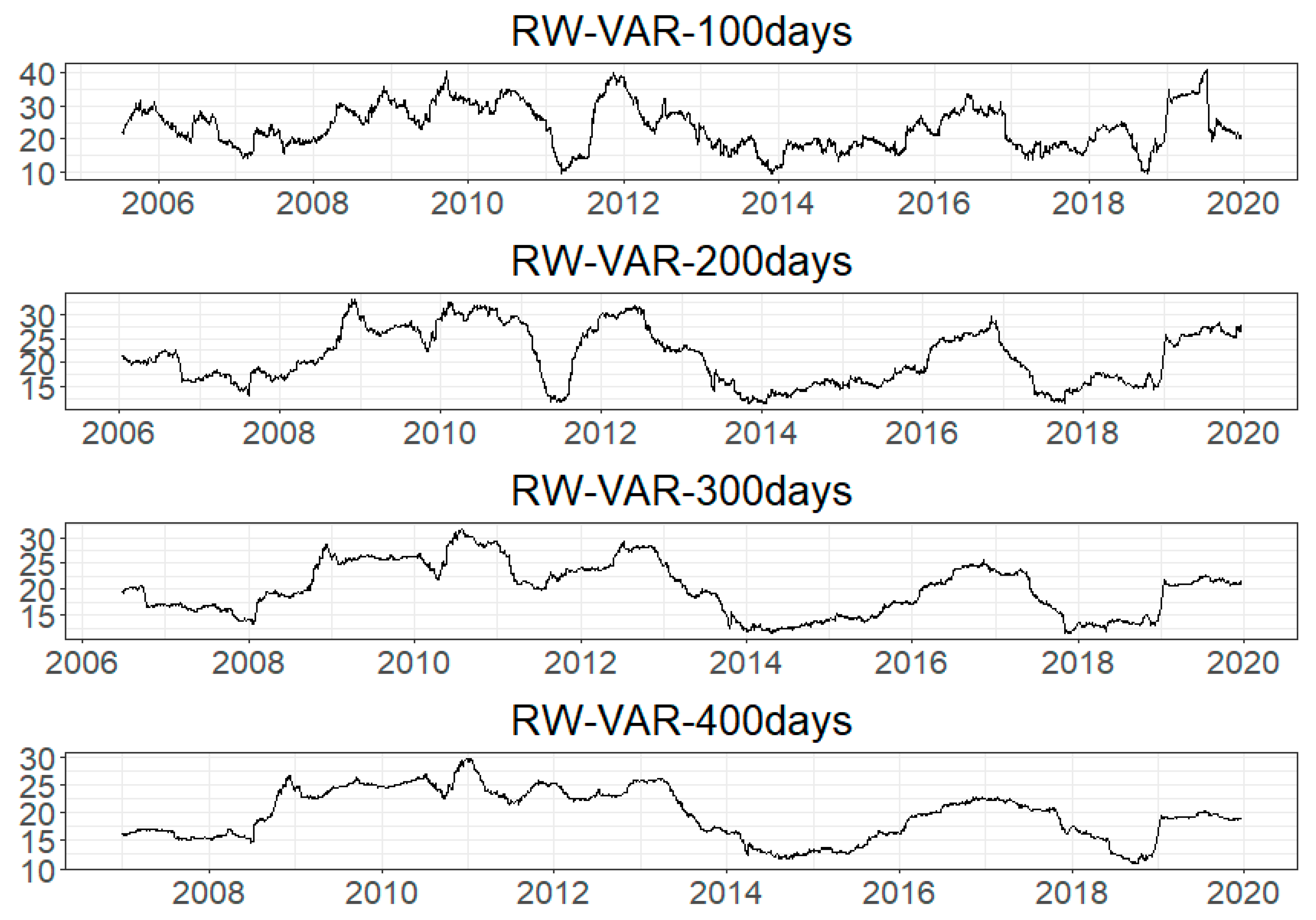
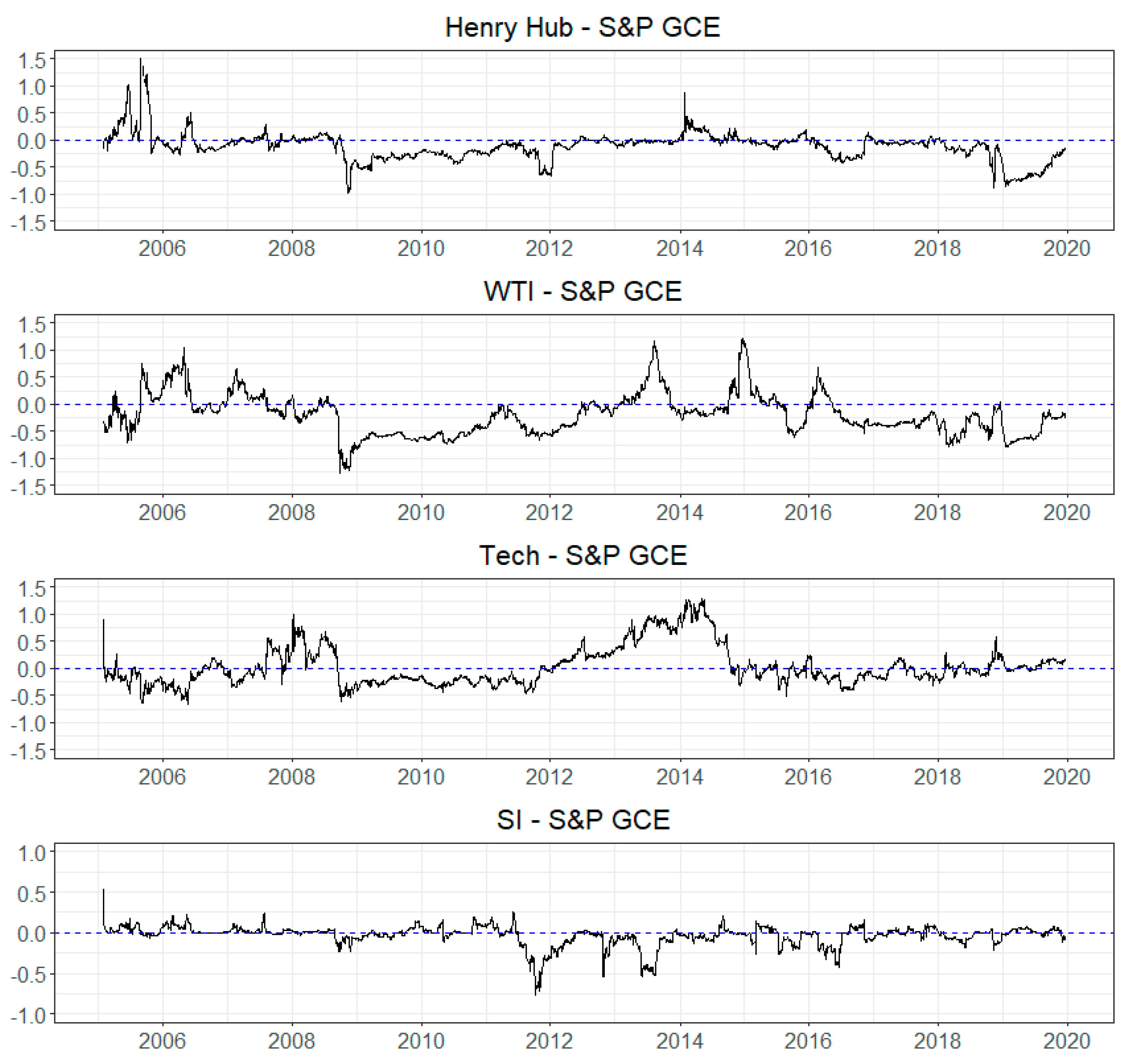
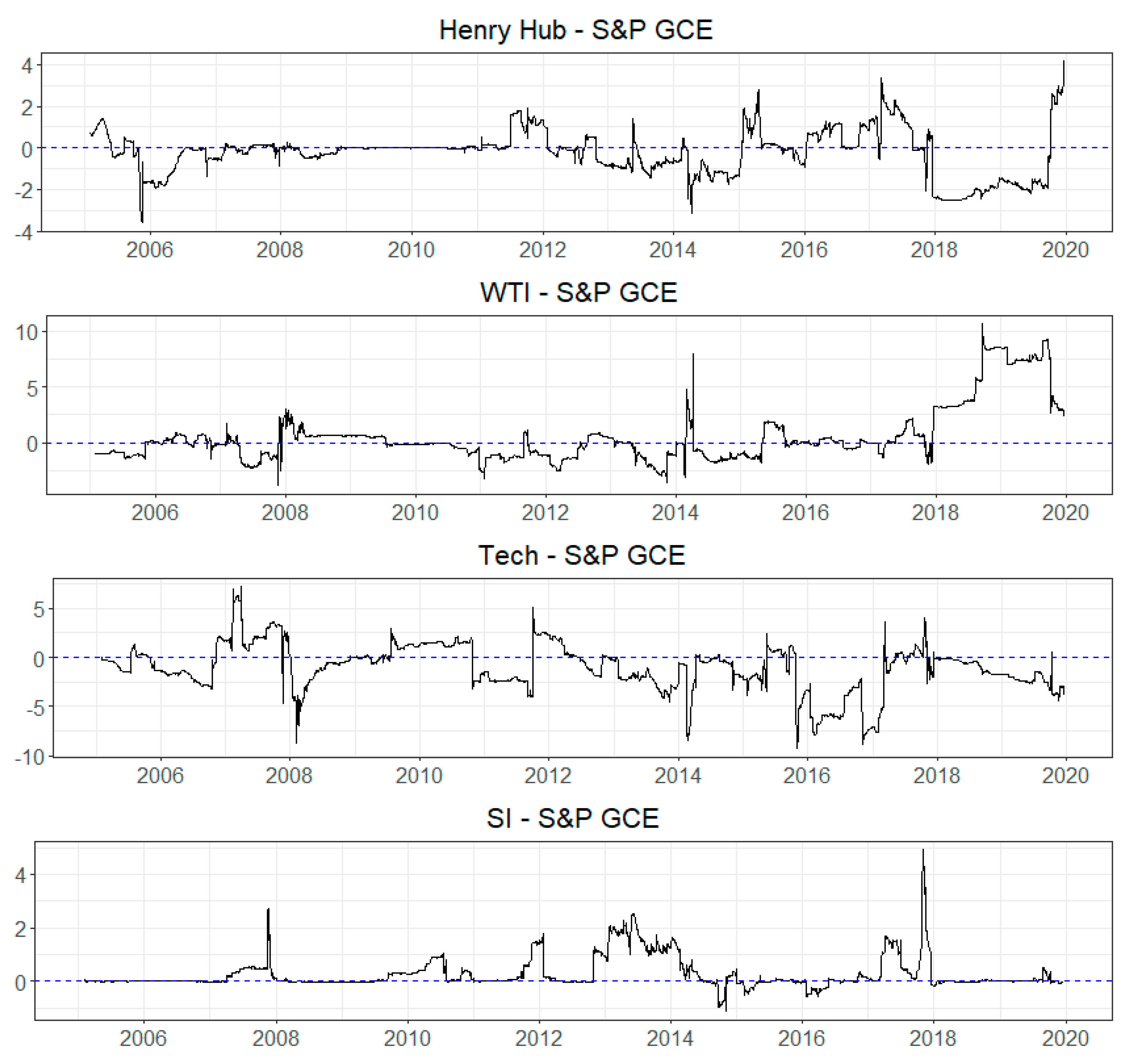
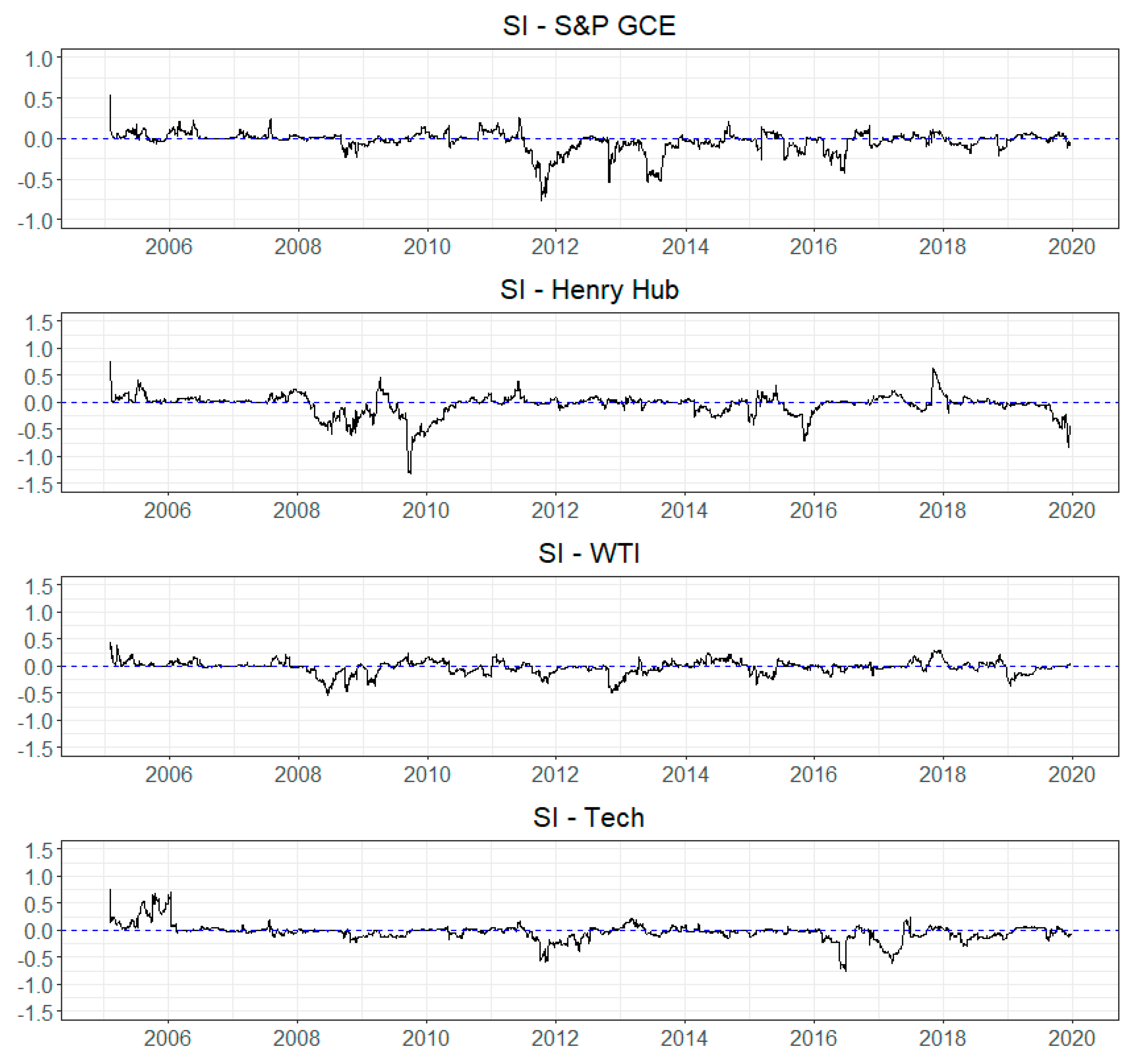
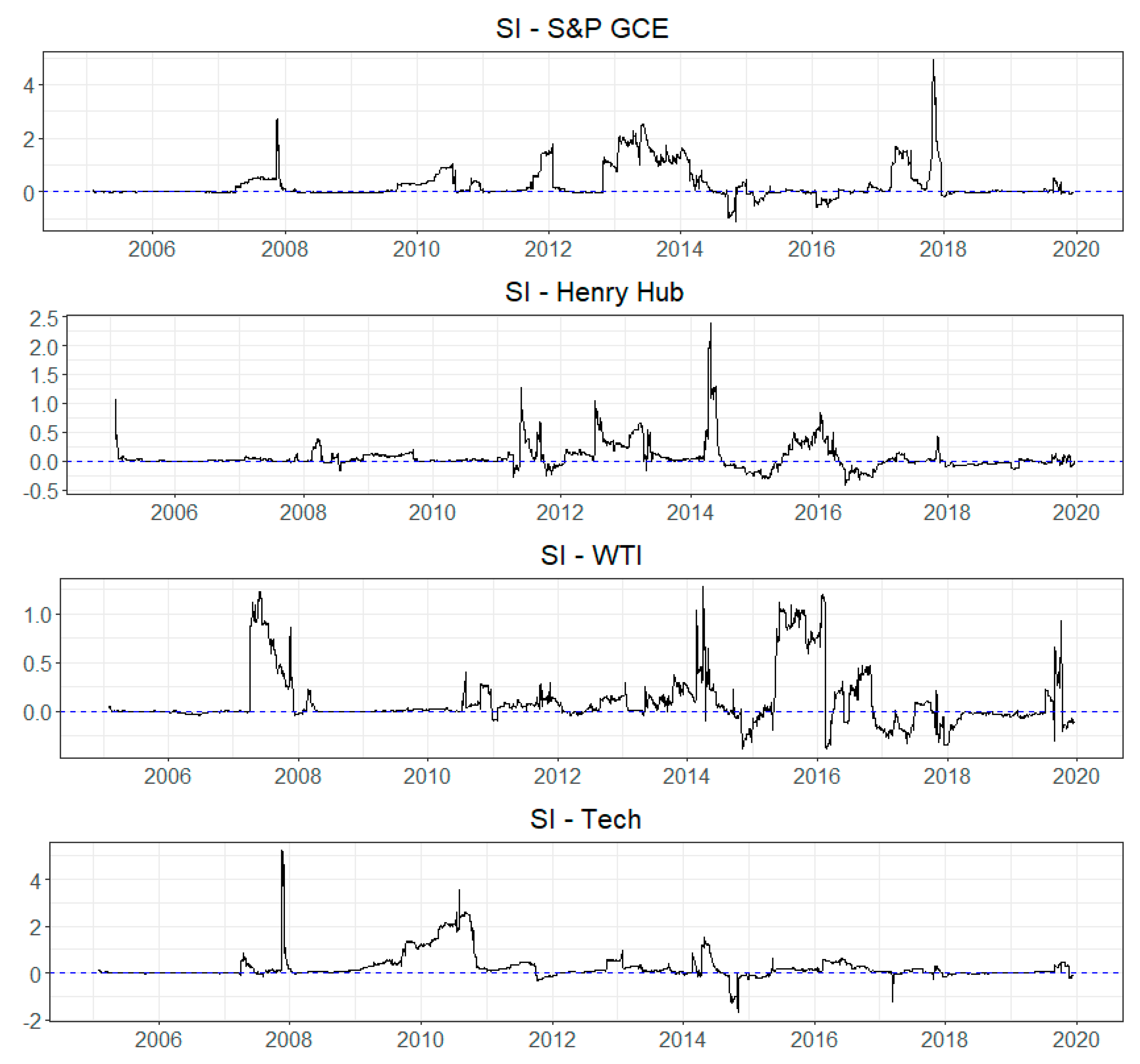
References
- Liu, T.; Hamori, S. Spillovers to Renewable Energy Stocks in the US and Europe: Are They Different? Energies 2020, 13, 3162. [Google Scholar] [CrossRef]
- Xia, T.; Ji, Q.; Zhang, D.; Han, J. Asymmetric and extreme influence of energy price changes on renewable energy stock performance. J. Clean. Prod. 2019, 241, 118338. [Google Scholar] [CrossRef]
- Uddin, G.S.; Rahman, M.L.; Hedström, A.; Ahmed, A. Cross-quantilogram-based correlation and dependence between renewable energy stock and other asset classes. Energy Econ. 2019, 80, 743–759. [Google Scholar] [CrossRef]
- Reboredo, J.C.; Ugolini, A. The impact of energy prices on clean energy stock prices. A multivariate quantile dependence approach. Energy Econ. 2018, 76, 136–152. [Google Scholar] [CrossRef]
- Henriques, I.; Sadorsky, P. Oil prices and the stock prices of alternative energy companies. Energy Econ. 2008, 30, 998–1010. [Google Scholar] [CrossRef]
- Ahmad, W. On the dynamic dependence and investment performance of crude oil and clean energy stocks. Res. Int. Bus. Financ. 2017, 42, 376–389. [Google Scholar] [CrossRef]
- Sadorsky, P. Correlations and volatility spillovers between oil prices and the stock prices of clean energy and technology companies. Energy Econ. 2012, 34, 248–255. [Google Scholar] [CrossRef]
- Kumar, S.; Managi, S.; Matsuda, A. Stock prices of clean energy firms, oil and carbon markets: A vector autoregressive analysis. Energy Econ. 2012, 34, 215–226. [Google Scholar] [CrossRef]
- Bahloul, W.; Bouri, A. The impact of investor sentiment on returns and conditional volatility in US futures markets. J. Multinatl. Financ. Manag. 2016, 36, 89–102. [Google Scholar] [CrossRef]
- Yang, C.; Gao, B. The term structure of sentiment effect in stock index futures market. N. Am. J. Econ. Financ. 2014, 30, 171–182. [Google Scholar] [CrossRef]
- Aloui, C.; Hkiri, B.; Lau, C.K.M.; Yarovaya, L. Investors’ sentiment and US Islamic and conventional indexes nexus: A time-frequency analysis. Financ. Res. Lett. 2016, 19, 54–59. [Google Scholar] [CrossRef]
- Ji, Q.; Li, J.; Sun, X. Measuring the interdependence between investor sentiment and crude oil returns: New evidence from the CFTC’s disaggregated reports. Financ. Res. Lett. 2019, 30, 420–425. [Google Scholar] [CrossRef]
- Dergiades, T. Do investors’ sentiment dynamics affect stock returns? Evidence from the US economy. Econ. Lett. 2012, 116, 404–407. [Google Scholar] [CrossRef]
- Reboredo, J.C.; Ugolini, A. The impact of twitter sentiment on renewable energy stocks. Energy Econ. 2018, 76, 153–169. [Google Scholar] [CrossRef]
- Song, Y.; Ji, Q.; Du, Y.J.; Geng, J.B. The dynamic dependence of fossil energy, investor sentiment and renewable energy stock markets. Energy Econ. 2019, 84, 104564. [Google Scholar] [CrossRef]
- Liu, T.; He, X.; Nakajima, T.; Hamori, S. Influence of Fluctuations in Fossil Fuel Commodities on Electricity Markets: Evidence from Spot and Futures Markets in Europe. Energies 2020, 13, 1900. [Google Scholar] [CrossRef]
- Zhang, Y.; He, X.; Nakajima, T.; Hamori, S. Oil, Gas, or Financial Conditions-Which One Has a Stronger Link with Growth? N. Am. J. Econ. Financ. 2020, 54, 101220. [Google Scholar] [CrossRef]
- Zhang, W.; Hamori, S. Crude oil market and stock markets during the COVID-19 pandemic: Evidence from the US, Japan, and Germany. Int. Rev. Financ. Anal. 2021, 74, 101702. [Google Scholar] [CrossRef]
- Diebold, F.X.; Yilmaz, K. On the network topology of variance decompositions: Measuring the connectedness of financial firms. J. Econom. 2014, 182, 119–134. [Google Scholar] [CrossRef]
- Antonakakis, N.; Gabauer, D. Refined Measures of Dynamic Connectedness Based on TVP-VAR. Available online: https://mpra.ub.uni-muenchen.de/id/eprint/78282 (accessed on 1 April 2021).
- Bouri, E.; Cepni, O.; Gabauer, D.; Gupta, R. Return connectedness across asset classes around the COVID-19 outbreak. Int. Rev. Financ. Anal. 2021, 73, 101646. [Google Scholar] [CrossRef]
- Antonakakis, N.; Gabauer, D.; Gupta, R.; Plakandaras, V. Dynamic connectedness of uncertainty across developed economies: A time-varying approach. Econ. Lett. 2018, 166, 63–75. [Google Scholar] [CrossRef]
- Gabauer, D.; Gupta, R. On the transmission mechanism of country-specific and international economic uncertainty spillovers: Evidence from a TVP-VAR connectedness decomposition approach. Econ. Lett. 2018, 171, 63–71. [Google Scholar] [CrossRef]
- Koop, G.; Korobilis, D. A new index of financial conditions. Eur. Econ. Rev. 2014, 71, 101–116. [Google Scholar] [CrossRef]
- Antonakakis, N.; Chatziantoniou, I.; Gabauer, D. Refined measures of dynamic connectedness based on time-varying parameter vector autoregressions. J. Risk Financ. Manag. 2020, 13, 84. [Google Scholar] [CrossRef]
- Koop, G.; Pesaran, M.H.; Potter, S.M. Impulse response analysis in non-linear multivariate models. J. Econom. 1996, 74, 119–147. [Google Scholar] [CrossRef]
- Pesaran, H.H.; Shin, Y. Generalized impulse response analysis in linear multivariate models. Econ. Lett. 1998, 58, 17–29. [Google Scholar] [CrossRef]
- Jarque, C.M.; Bera, A.K. Efficient tests for normality homoscedasticity and serial independence of regression residuals. Econ. Lett. 1980, 6, 255–259. [Google Scholar] [CrossRef]
- Elliott, G.; Rothenberg, T.J.; Stock, J.H. Efficient Tests for an Autoregressive Unit Root; Technical Working Paper 0130; National Bureau of Economic Research: Cambridge, MA, USA, 1992. [Google Scholar] [CrossRef]
- Fisher, T.J.; Gallagher, C.M. New weighted portmanteau statistics for time series goodness of fit testing. J. Am. Stat. Assoc. 2012, 107, 777–787. [Google Scholar] [CrossRef]
- Manage, S.; Okimoto, T. Does the price of oil interact with clean energy prices in the stock market? Jpn. World Econ. 2013, 27, 1–9. [Google Scholar] [CrossRef]
- Li, L.; Yin, L.; Zhou, Y. Exogenous shocks and the spillover effects between uncertainty and oil price. Energy Econ. 2016, 54, 224–234. [Google Scholar] [CrossRef]
- Křehlík, T.; Baruník, J. Cyclical properties of supply-side and demand-side shocks in oil-based commodity markets. Energy Econ. 2017, 65, 208–218. [Google Scholar] [CrossRef]
- Ferrer, R.; Shahzad, S.J.H.; López, R.; Jareño, F. Time and frequency dynamics of connectedness between renewable energy stocks and crude oil prices. Energy Econ. 2018, 76, 1–20. [Google Scholar] [CrossRef]
- Ang, A.; Chen, J. Asymmetric correlations of equity portfolios. J. Financ. Econ. 2002, 63, 443–494. [Google Scholar] [CrossRef]
- Hong, Y.; Tu, J.; Zhou, G. Asymmetries in stock returns: Statistical tests and economic evaluation. Rev. Financ. Stud. 2007, 20, 1547–1581. [Google Scholar] [CrossRef]
- Longin, F.; Solnik, B. Extreme correlation of international equity markets. J. Financ. 2001, 56, 649–676. [Google Scholar] [CrossRef]
- Chatziantoniou, I.; Gabauer, D. EMU risk-synchronisation and financial fragility through the prism of dynamic connectedness. Q. Rev. Econ. Financ. 2021, 79, 1–14. [Google Scholar] [CrossRef]
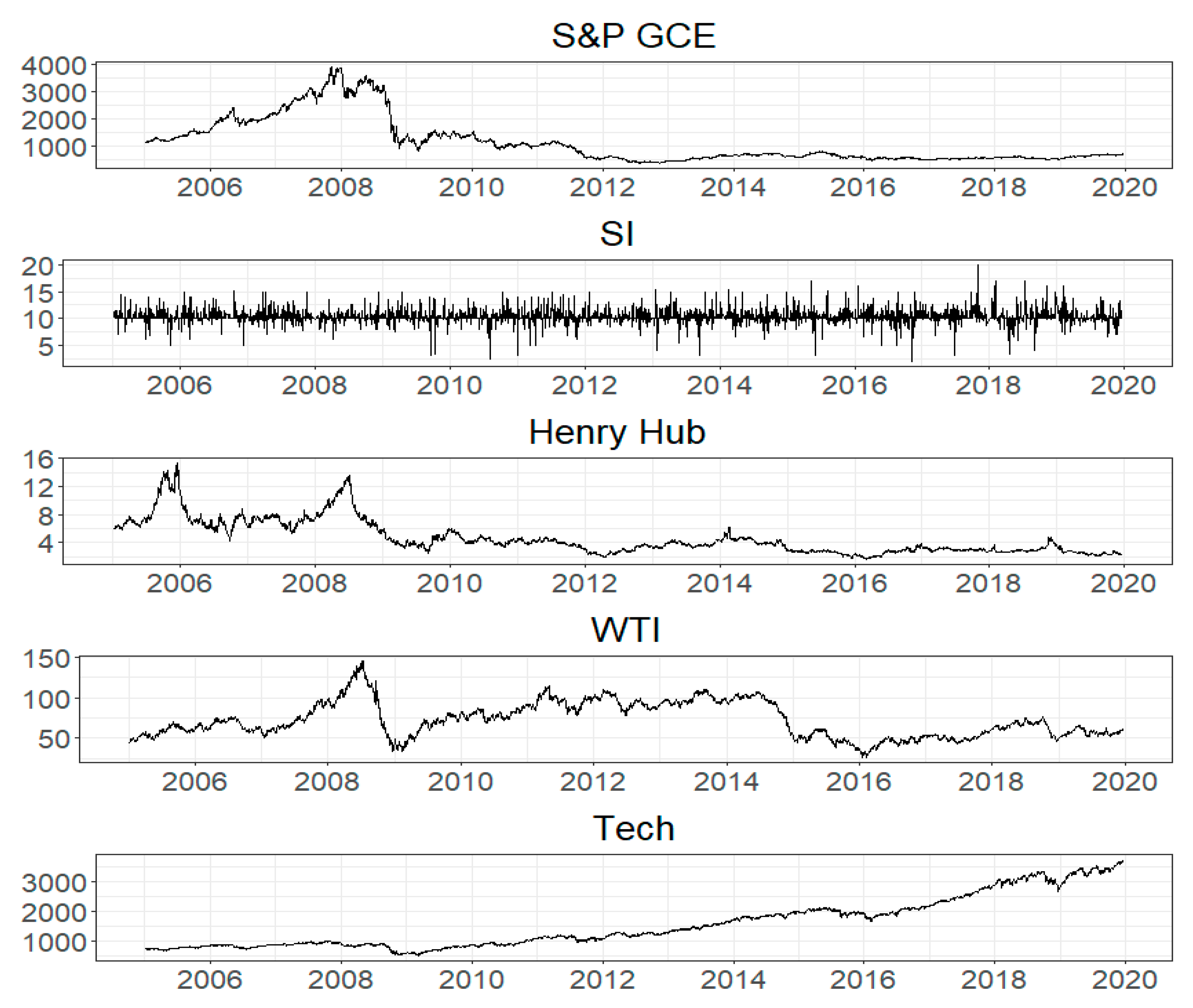
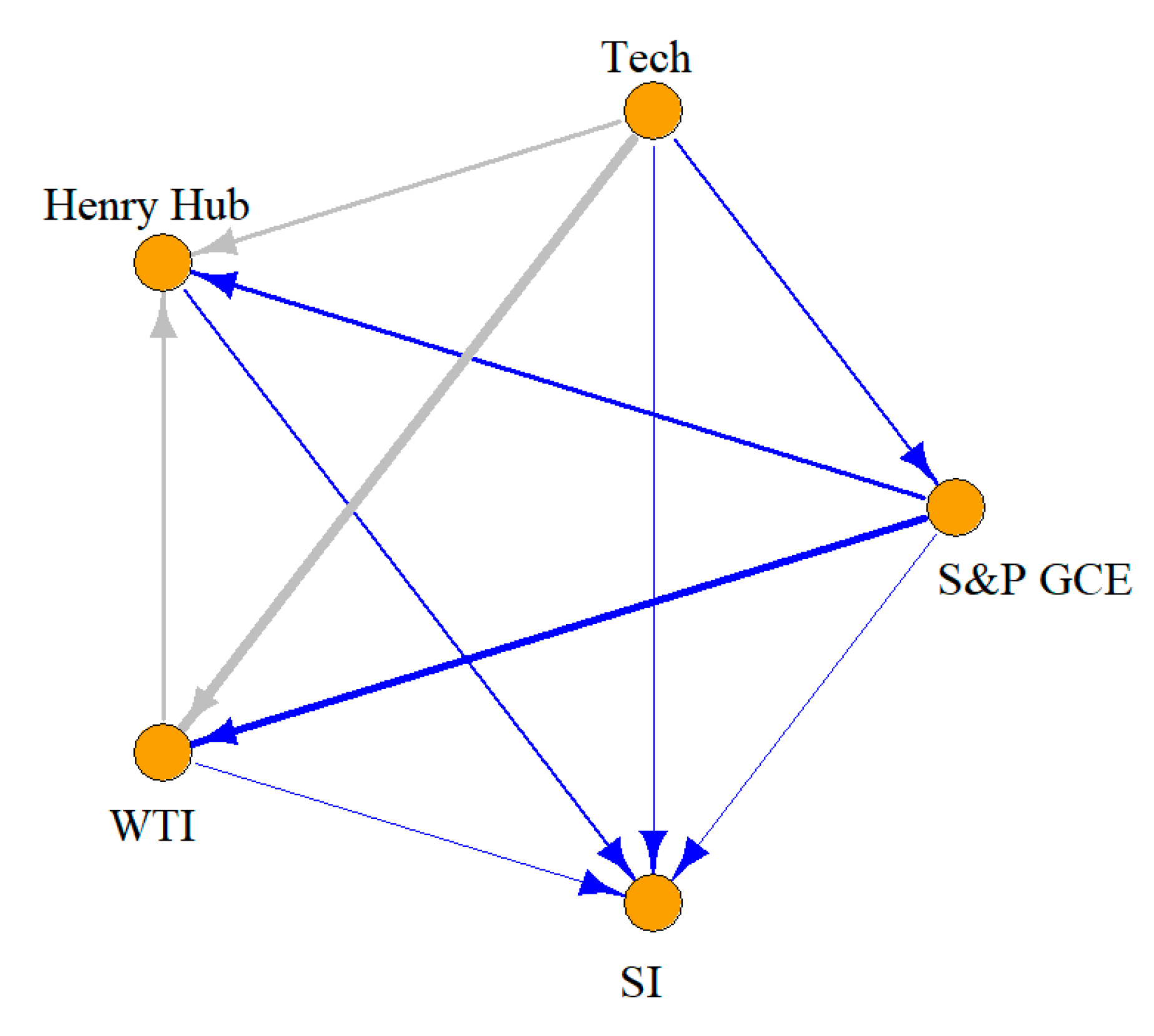
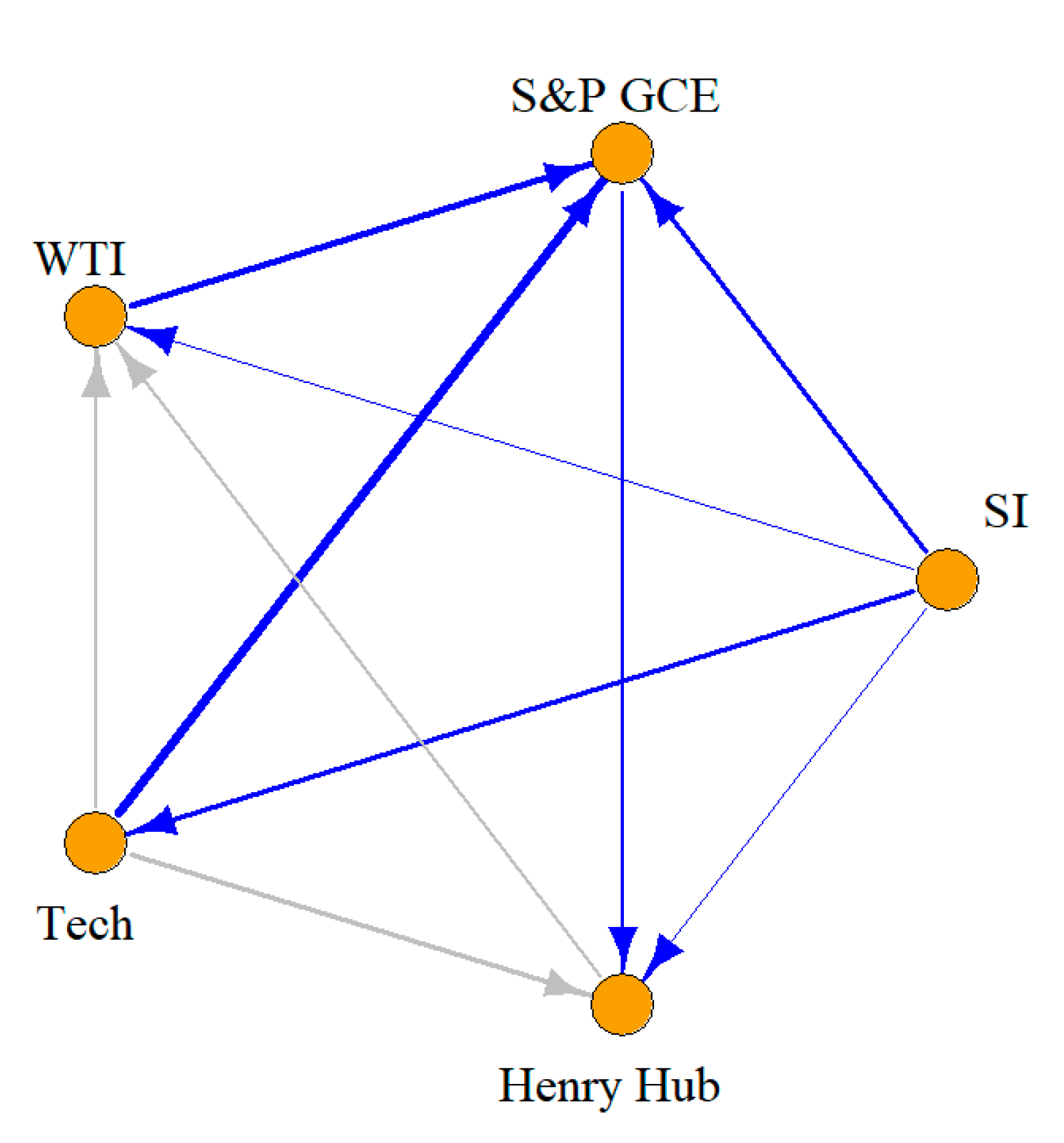

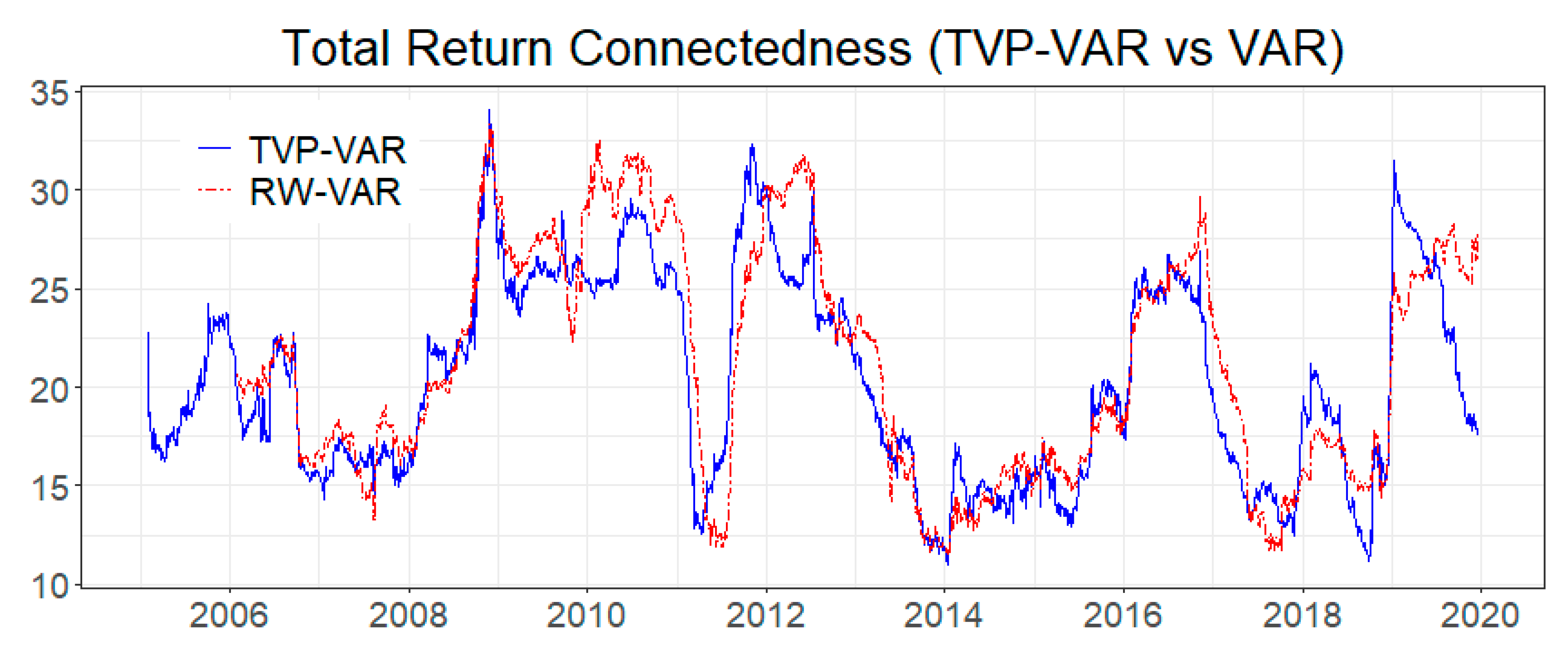
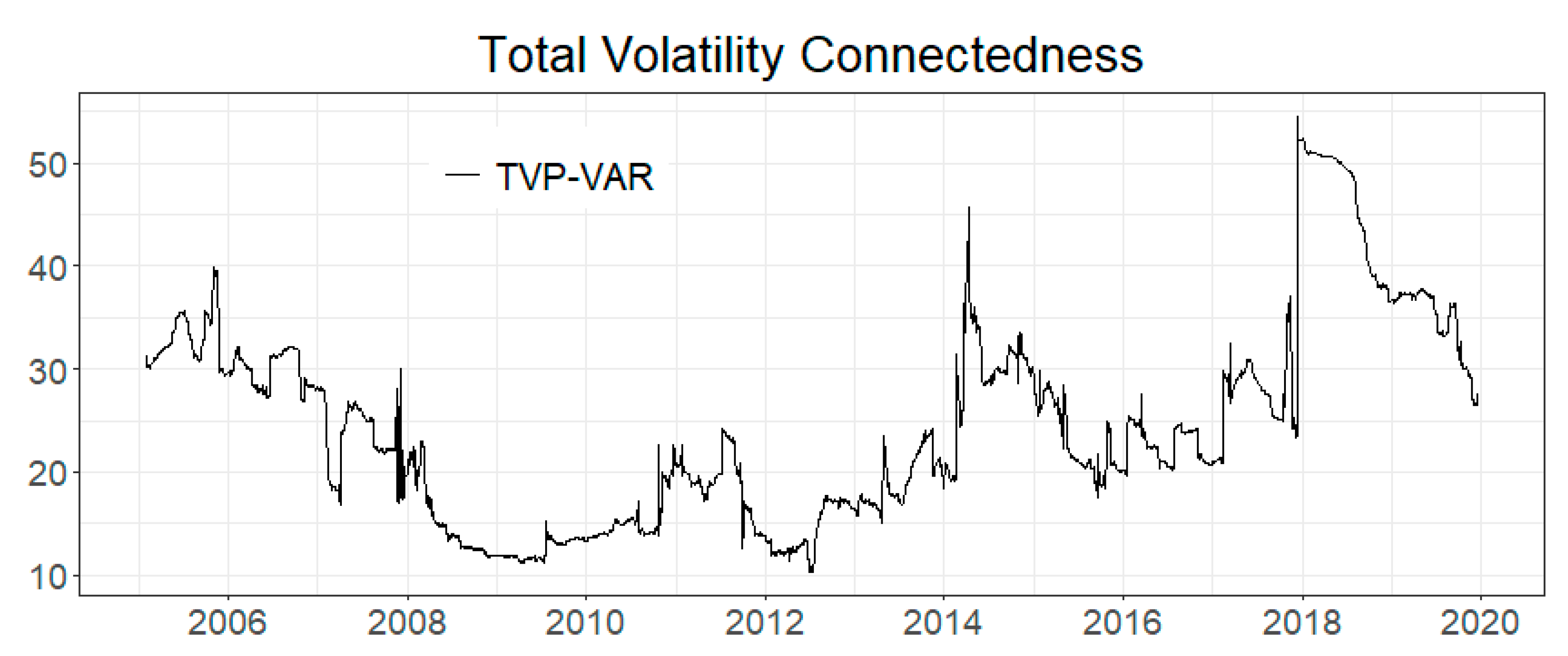
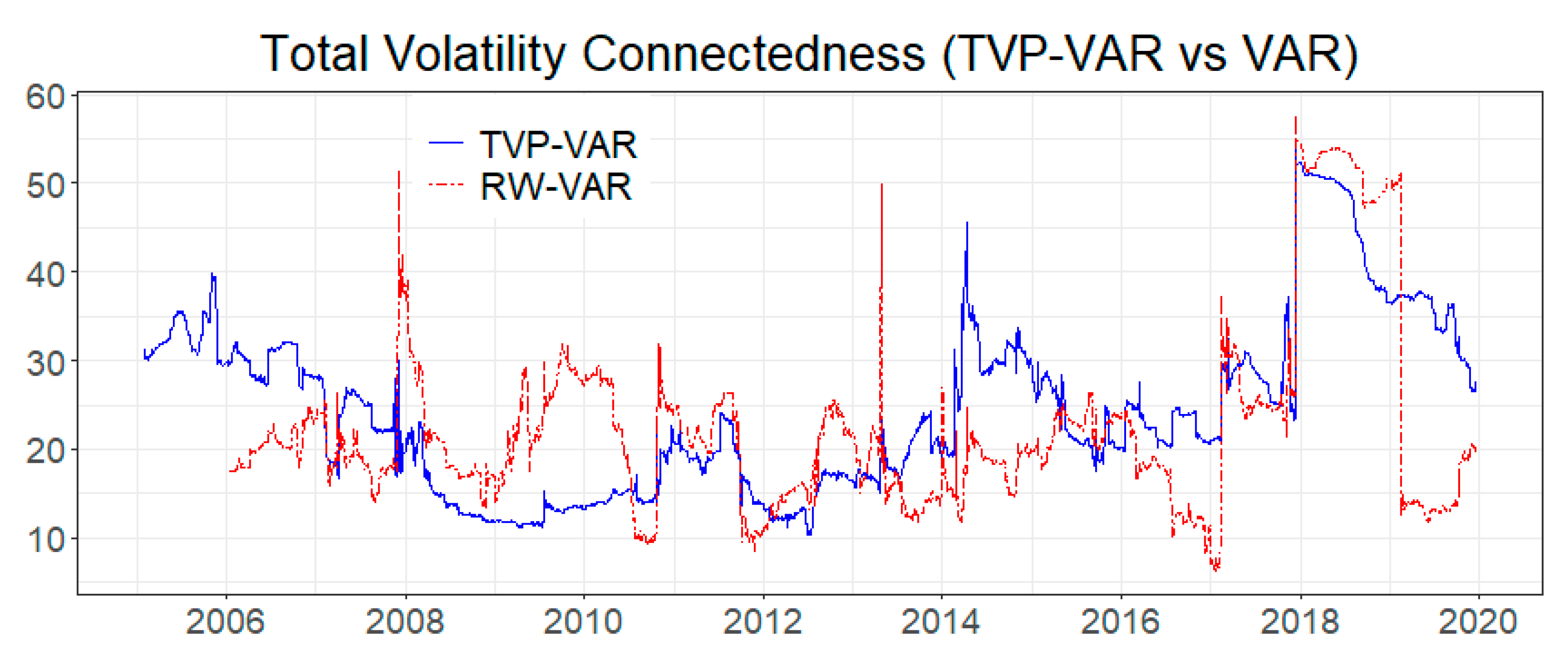
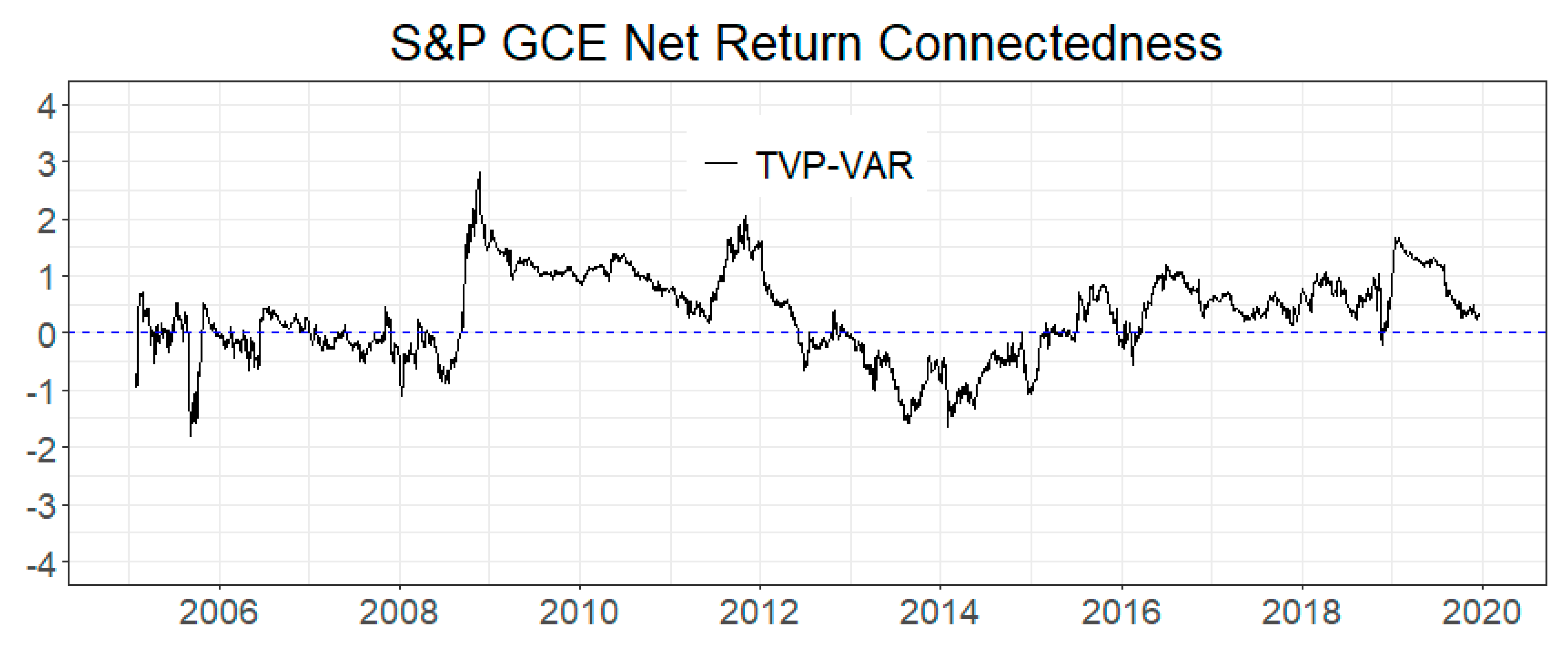
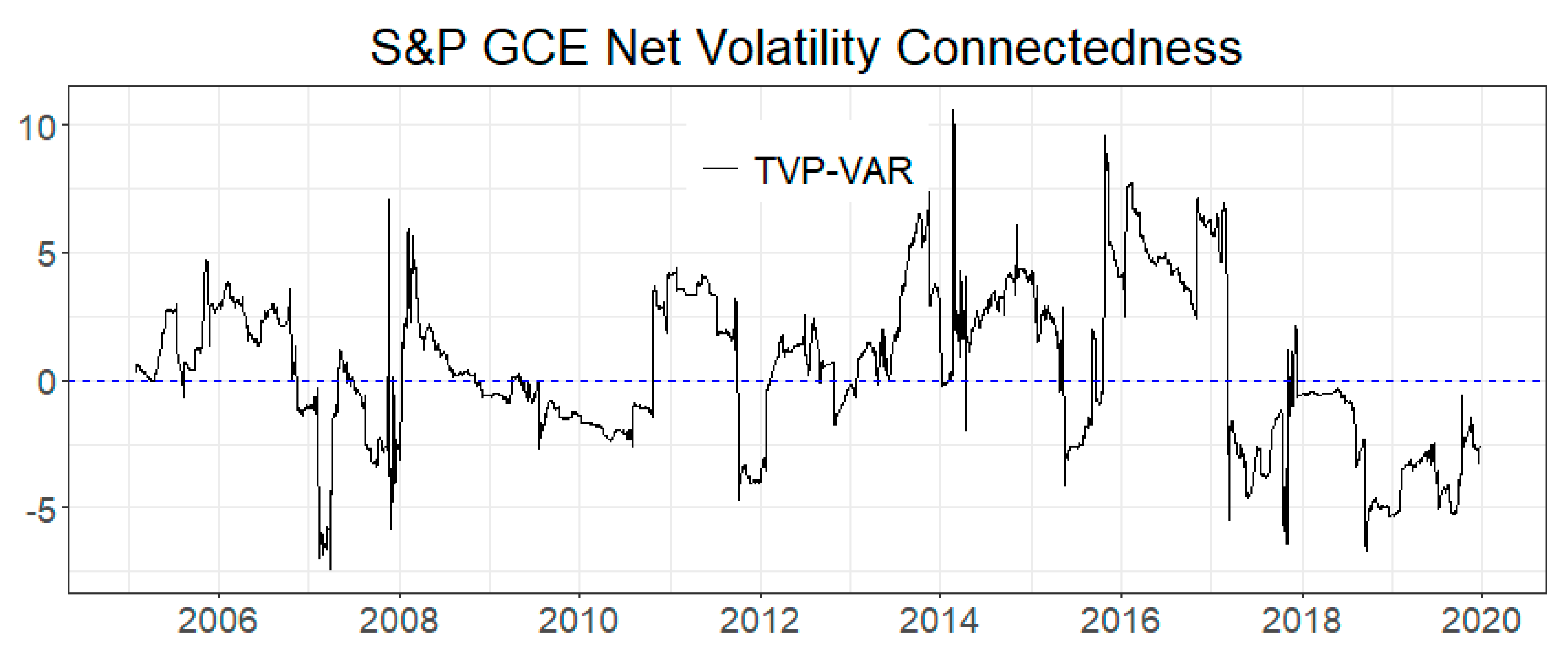
| Descriptive Statistics | |||||||
|---|---|---|---|---|---|---|---|
| Mean | Skewness | Kurtosis | JB | ERS | Q (20) | Q2 (20) | |
| Descriptive Statistics of the Return | |||||||
| S&P GCE | −0.0001 | −0.20 | 14.25 | 17,323.00 *** | −12.37 *** | 124.95 *** | 4438.90 *** |
| Henry Hub | −0.0003 | 0.76 | 14.84 | 19,463.00 *** | −12.67 *** | 47.42 *** | 101.87 *** |
| WTI | 0.0001 | 0.41 | 9.61 | 6057.50 *** | −14.56 *** | 46.07 *** | 959.98 *** |
| Tech | 0.0005 | −0.07 | 9.18 | 5227.30 *** | −17.09 *** | 59.50 *** | 1803.40 *** |
| Descriptive Statistics of the Volatility | |||||||
| S&P GCE | 0.0004 | 5.84 | 42.02 | 226,800.00 *** | −3.27 *** | 31,233.00 *** | 28,301.00 *** |
| Henry Hub | 0.0012 | 5.73 | 55.31 | 392,012.00 *** | −5.22 *** | 19,180.00 *** | 10,270.00 *** |
| WTI | 0.0006 | 4.74 | 33.16 | 136,589.00 *** | −4.59 *** | 31,159.00 *** | 27,158.00 *** |
| Tech | 0.0002 | 5.10 | 38.83 | 189,703.00 *** | −5.68 *** | 23,773.00 *** | 18,520.00 *** |
| Descriptive Statistics of the Investor Sentiment | |||||||
| SI | 10.2483 | 0.28 | 12.65 | 12,761.00 *** | −21.88 *** | 9.46 *** | 12.64 *** |
| S&P GCE | SI | Henry Hub | WTI | Tech | From | |
|---|---|---|---|---|---|---|
| S&P GCE | 64.5 | 0.5 | 1.6 | 7.8 | 25.7 | 35.5 |
| SI | 0.6 | 97.0 | 1.0 | 0.7 | 0.7 | 3.0 |
| Henry Hub | 2.1 | 0.8 | 90.5 | 5.2 | 1.4 | 9.5 |
| WTI | 8.8 | 0.6 | 4.7 | 79 | 6.8 | 21.0 |
| Tech | 25.5 | 0.6 | 0.9 | 6.0 | 67.0 | 33.0 |
| To | 37.0 | 2.5 | 8.2 | 19.7 | 34.6 | Total: 20.4 |
| Net | 1.4 | −0.5 | −1.3 | −1.3 | 1.6 |
| S&P GCE | SI | Henry Hub | WTI | Tech | From | |
|---|---|---|---|---|---|---|
| S&P GCE | 63.1 | 1.8 | 2.7 | 11.6 | 20.8 | 36.9 |
| SI | 0.4 | 98.4 | 0.4 | 0.4 | 0.5 | 1.6 |
| Henry Hub | 3.7 | 0.8 | 87.8 | 3.6 | 4.1 | 12.2 |
| WTI | 9.6 | 1.0 | 4.3 | 73.4 | 11.7 | 26.6 |
| Tech | 26.1 | 1.8 | 2.8 | 10.8 | 58.5 | 41.5 |
| To | 39.8 | 5.3 | 10.2 | 26.4 | 37.1 | Total: 23.8 |
| Net | 2.9 | 3.7 | −2.0 | −0.2 | −4.5 |
Publisher’s Note: MDPI stays neutral with regard to jurisdictional claims in published maps and institutional affiliations. |
© 2021 by the authors. Licensee MDPI, Basel, Switzerland. This article is an open access article distributed under the terms and conditions of the Creative Commons Attribution (CC BY) license (https://creativecommons.org/licenses/by/4.0/).
Share and Cite
Liu, T.; Hamori, S. Does Investor Sentiment Affect Clean Energy Stock? Evidence from TVP-VAR-Based Connectedness Approach. Energies 2021, 14, 3442. https://doi.org/10.3390/en14123442
Liu T, Hamori S. Does Investor Sentiment Affect Clean Energy Stock? Evidence from TVP-VAR-Based Connectedness Approach. Energies. 2021; 14(12):3442. https://doi.org/10.3390/en14123442
Chicago/Turabian StyleLiu, Tiantian, and Shigeyuki Hamori. 2021. "Does Investor Sentiment Affect Clean Energy Stock? Evidence from TVP-VAR-Based Connectedness Approach" Energies 14, no. 12: 3442. https://doi.org/10.3390/en14123442
APA StyleLiu, T., & Hamori, S. (2021). Does Investor Sentiment Affect Clean Energy Stock? Evidence from TVP-VAR-Based Connectedness Approach. Energies, 14(12), 3442. https://doi.org/10.3390/en14123442








